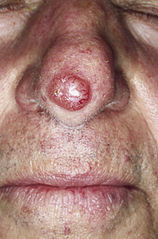22 Jul Kaiser Study Reports Clustering of Basal Cell Skin Cancers in Northern California
MedicalResearch.com Interview with:
G. Thomas (Tom) Ray
Division of Research, Kaiser Permanente
2000 Broadway
Oakland, CA 94612-2304
MedicalResearch.com: What is the background for this study?
Response: Basal cell carcinoma (BCC) is the most common cancer in the United States. BCCs tend to develop on sun-exposed areas such as the head and neck and are typically treated with various surgical techniques in an outpatient setting. Although BCCs are rarely fatal, they have been estimated to be among the most costly cancers in the Medicare population due to their high incidence. Yet because these cancers are not tracked by national registries the way, for example, melanoma is, basal cell carcinomas have been difficult to study. Incidence rates in the past have tended to rely on surveys such as those by the National Cancer Institute. And studies using disease codes have, until recently, been difficult because the codes used for basal cell carcinoma and squamous cell carcinoma were the same.
Since 1997, Kaiser Permanente Northern California (KPNC) has had computerized pathology results that allowed us to develop an internal registry of BCC cancers. In addition to having detailed information about basal cell cancer patients, we also had detailed information on the underlying population – KPNC members – which allowed us to determine incidence rates of BCC by age, sex, and most importantly for this study, by geographic location. This is because we know the residential location of all KPNC members at any given time – both those that get basal cell cancer and those who do not. This combination of a validated BCC registry with a well-defined population at-risk gave us the unique ability to investigate the spatial distribution of BCC in Northern California and assess whether there existed geographic clustering of basal cell cancers. Although the investigation of spatial clustering of other cancers is fairly common, no such analyses have been performed for basal cell cancer in the United States.
MedicalResearch.com: What are the main findings?
Response: In years 2011-2012, we identified over 28,000 BCC cases in the white, non-Hispanic, adult KPNC population. The overall BCC incidence rate in this population was 930 cases per 100,000 person-years. We identified five discrete geographic areas in Northern California with moderately elevated rates of BCC, after adjusting for age, sex and neighborhood socioeconomic status. Rates of basal cell cancer in these areas were 17% to 30% higher than outside of those areas. One of the geographic clusters covered parts of Marin County, which was consistent with other studies finding elevated rates melanoma cancer there.
MedicalResearch.com: What should clinicians and patients take away from your report?
Response: We believe that the clusters we have identified are likely explained by a higher concentration of persons with individual-related BCC risk factors (such as exposure to ultraviolet radiation) living in those areas, as opposed to any characteristics unique about the geography of the area. It is also possible that these basal cell cancer clusters may be related to differences in access to services and differences in the propensity of persons to seek treatment – although differences in access to services are mitigated in this population, all of whom were members of the same health plan.
MedicalResearch.com: What recommendations do you have for future research as a result of this study?
Response: In part, our study was of a methodological nature. Unlike many spatial analyses of disease that have been published, we used a more rigorous statistical approach that is far less affected by arbitrary geographic boundary definitions (such as county or ZIP code), and which adjusts for multiple testing. We recommend such techniques for future analyses. In addition, we view the main purposes of identifying geographic clusters of disease to be to identify areas for more efficient targeting of screening and prevention efforts and as an aid in the generation of etiological hypotheses.
MedicalResearch.com: Thank you for your contribution to the MedicalResearch.com community.
Citation:
Ray G, Kulldorff M, Asgari MM. Geographic Clusters of Basal Cell Carcinoma in a Northern California Health Plan Population.JAMA Dermatol. Published online July 20, 2016. doi:10.1001/jamadermatol.2016.2536.
Note: Content is Not intended as medical advice. Please consult your health care provider regarding your specific medical condition and questions.
More Medical Research Interviews on MedicalResearch.com
[wysija_form id=”5″]
Last Updated on July 22, 2016 by Marie Benz MD FAAD

